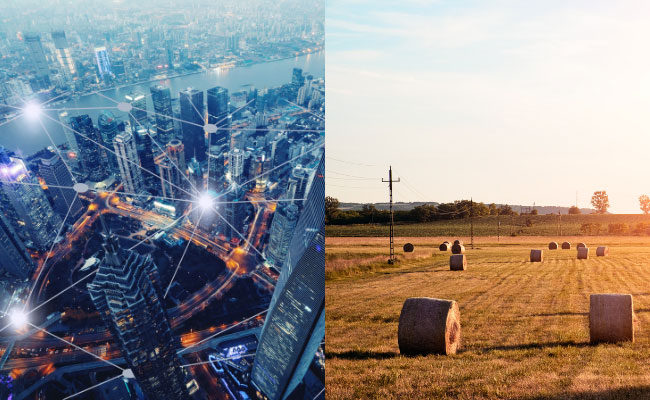BLOG
BLOG
Beyond the Buzz: 5G - Not Great, Not Terrible
JULY 30, 2024
So, 5G - the great networking innovation that was going to propel our world’s digital infrastructure to a new level of ultra-fast connectivity we’ve never seen before but endlessly demand.
We were going to be leaps and bounds away from the compromised connectivity and spotty service of 4G.
Every cellular device was to become a conduit for augmented and virtual reality with seamless performance everywhere and near-instant uploads / downloads for your favorite (perhaps cat-oriented) content.


There was even a social element too: even the smallest rural communities would have the same or similar connectivity to the biggest cities in the world – the benefits to healthcare, remote work, and basic communication seemed enormous.
And then only some of that happened. A lot of it didn’t happen at all.
5G turned into - and has remained - a controversial subject.
There is no doubt that the 5G rollout has been incredibly slow and incremental. And somewhere along the way, things got a little confusing. A lot of misinformation has been circulating from a variety of sources - some reputable, some less so, and some venturing onto the wilder side.
5G is a gigantic topic, and over the course of this mini-series, we’ll be going Beyond the Buzz, breaking down what 5G is - and isn’t. We’ll be as honest as we can about what’s real, what’s purely marketing, and what we can expect in the future.
So, let’s jump in.
What is 5G?
Suppose you are on your morning commute and see a new Instagram notification. You recklessly endanger others by picking up your smartphone and scrolling through your Instagram feed (which is illegal, and Mitsubishi Electric highly recommends you do NOT do this).
If you’re driving from city to city through rural areas, you may be utilizing an upgraded LTE 4G network operated by a telecom like Verizon or T-Mobile.
The signal is bounced off a wireless tower operated by a regional company like US Cellular, converted to optic signal and run along a fibre network operated by a company like Lumen Technologies. And, depending on your mobile activity, it’s then computed by a public cloud or hyperscale data center company like Facebook, Google, Microsoft or AWS.
Then the whole process happens in reverse back to your device so that you can comment on your favorite cat video.

Even though there have been countless systems handshaking your data from one end of the digital spectrum to the other, if this happens near instantly, it meets your expectations.
But if it takes longer than instantaneous, you’re probably a little irritated. And depending on your location, provider, and the supporting network infrastructure, your data might not have run on 5G technology at all.
How could this be possible when 5G was first announced back in 2017? What have telecoms being doing all this time? What is this 5G thing anyway?
5G means different things to different people. It might be:
- A new set of characters you noticed between the connection bars and the battery icon on your cell phone
- The secret sauce 12-year-old professional gamers use to dominate on PvP
- A quicker means to instantly update your tens of followers with the cutest new video of Mr. Whiskers
- The enabler of your doomscrolling tendencies
There are countless ways to describe what this global project could mean to the common user. But the textbook definition of 5G is the fifth generation of cellular / wireless networks using “New Radio” or 5G NR-powered software (some of my networking colleagues still laugh about how they chose “New Radio” as the official name).
Work Groups vs. Telecom Companies vs. Governing Bodies
The textbook definition of “5G” is handled by two different international workgroups:
|
|
The International Telecommunications Union (ITU) sets guidelines, requirements, and expectations. |
 |
The 3rd Generation Partnership Project sets standards and specifications for developing products and services. |
Neither of these groups are regulatory bodies - they cover the technology definitions and standards. Neither of these groups actually deploy infrastructure or decide what New Radio devices will be in different countries’ digital and physical infrastructure. They don’t decide where to put the roads or how to build them - they make sure we all know what a road is.
Deployment and infrastructure are handled by the complex interaction between local, regional and national telecommunications companies, their relationship with larger telecom (e.g., AT&T, Verizon, and T-Mobile), and governmental bodies regulating the use of different frequencies of radio waves.
The best 5G technology is a clear step forward from the 4G LTE networks but, in many ways, 5G remains foundationally and fundamentally dependent on them. (More on that in the next blog).
Even the 4G LTE technology described here is upgraded beyond its 2009 characteristics. The big three telecom carriers have said for years that upgraded LTE is 5G tech, whereas plenty of industry watchers and insiders have denied this outright. But the fact remains, no matter how many fuel injectors you have in your Maserati, the internal combustion engine is still a 19th century technology.
Frequency Bands
5G devices are much more intensive in terms of downloads and uploads, so they have smaller frequencies and more limited ranges.
For example, millimeter wave frequency (mmWave) is the highest form of frequency band used; it can carry 20GHz signals for truly impressive capacity and speed, but they’re only useful extremely close to New Radio transmitters on telecom towers (think a stadium, university, or other specific location). The company Waveform has a nice breakdown of 5G frequency bands.
What this means is that to take advantage of 5G’s benefits, you need to be pretty close to a cell tower powered by 5G New Radio devices. The high-capacity download speeds associated with mmWave are only available over a very short range – which is precisely why you may see “LTE” when you are outside your mobile service provider’s 5G network.
Edge vs.5G
Before we go any further, we need to make a clear distinction: 5G and the Edge have both turned into buzzwords that still describe real innovations in digital infrastructure. However, they’re not the same.
- Edge computing describes placing storage and compute closer to the end user to minimize latency.
- 5G is the next generation of cellular devices being deployed in digital infrastructure all over the world.
An Edge data center may use some of the 5G technologies described, and 5G deployments may be at the Edge, but they are not interchangeable, no matter how many times marketing puts them right next to each other in official statements.
Want to learn more about edge? Discover the True Pulse of the Edge Data Center Market.
5G Applications
All the new 5G applications are intended to reduce latency, increase connectivity, and profoundly improve mobile performance. As defined by the ITU, the innovations seem to be focused on specific applications and use cases:

Enhanced Mobile Broadband (eMBB)
- eMBB uses high download and upload speeds in the midband spectrum (1GHz to 6GHz) to allow users to use high definition video streaming, as well as AR and VR applications.
- Due to the high frequency nature of the radio waves, and the shorter wavelength, this application is best for short range applications, such as stadiums, airports, or other high density population areas with plenty of 5G infrastructure available. You will need to be within a few hundred yards of a eMBB device in order to use this 5G service, as the short wavelengths are not effective over even a moderate distance and are susceptible to line-of-sight constraints.
Ultra Low Latency Communications (URLLC)
- URLLC is focused on low latency, mission-critical applications like remote surgery and autonomous vehicles where the use case demands as low latency as possible to function.
- URLLC is also used for smart factories and retail environments, such as computer and machine vision for production line and no checkout shopping
- According to the guidelines set out by 3GPP, a reliability grade of 99.999%, or three nines, is required. Five nines, or reliability of 99.99999% is claimed by some.
- Due to the expected loss in wavelength, frequency ranges for URLLC are even higher, so these applications are extremely localized. (This is one of the biggest challenges associated with autonomous vehicles right now, where 1 millisecond end-to-end latency is required).
Massive Machine Type Communications (mMTC)
- mMTC is largely an Internet of Things and smart cities application allowing for up to 1 million devices per square kilometer to be connected, transmitting small amounts of data for quick analysis. An example of this would be smart metering for power or water utilities.
- This will allow 10x more devices to be connected within the network than under 4G technology
5G Rollout
People have been talking about 5G since 2017 when the working groups first released their definitions and guidelines, which included an expectation that 20GB/s would be the download speed.
However, the big telecom companies achieving just 1GB/s everywhere is still aspirational rather than realistic - at least when considering every user in every wireless network.
All these 5G developments are great if you’re in a stadium or surrounded by New Radio transmitters. Depending on where you are, they may not.

If you’re curious about the average upload and download speeds you can expect in your own work or personal network, use this online speed test tool from Ookla to find out.
There are also quarterly national reports if you’re curious about where on the download / upload speeds scale you fall into.
The transition from 4G technologies to 5G is a very slow process (like all big infrastructural developments unfortunately).
Rural connectivity has been an issue since the 2000s, and while there have been a lot of marketing pronouncements to the contrary, there remains huge issues of expense, infrastructure, and customer adoption for rural users.
Use cases for underserved users will be a subject we return to in this series.
If you’re interested in discovering more about how your information packets travel from your phone to a telecom central office or data center for processing, take a look at this Wikipedia article on the Open Systems Interconnection (OSI) model.
So now that we have a basic idea of what 5G is, and isn’t, the next few blogs of Beyond the Buzz will look at the state of 5G and how we got here. We’ll take an honest look at the technologies being deployed and when we all may be able to use them.
Edited by Nicole Kristof, Senior Marketing Specialist
Stay up-to-date on industry trends & insights
Be the first notified of new blog posts
By submitting this contact form, you agree that a representative(s) of Mitsubishi Electric Power Products, Inc. (MEPPI) may contact you using the information you provided. In accordance with our Privacy Policy, we will never share or sell your personal data.
